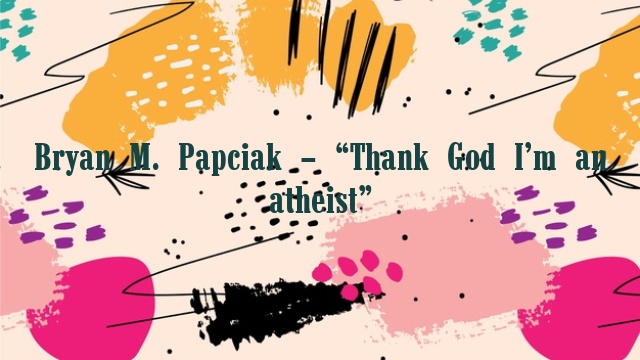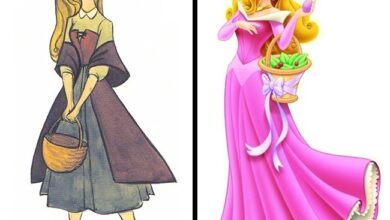
Bryan M. Papciak – “Thank God I’m an atheist”
The surrealistic cinema of Luis Bunuel
“The thought of death has been familiar to me for a long time,” says Director Luis Bunuel. “From the time that skeletons were carried through the streets of Calanda during the Holy Week procession, death has been an integral part of my life. I’ve never wished to forget or deny it, but there’s not much to say about it when you’re an atheist”. So reads an accurate testimonial to the personal and artistic sentiment of this odd and serious filmmaker. Like many of his contemporary surrealists, Bunuel is a paradox who on one hand claims apathy towards ultimate end, being, and Being, yet on the other hand loads his impressive body of work with moribund imagery and strange ideas about the God he so vociferously denies. Bunuel exhibits a radical, iconoclastic view of the world in which he finds society decadent and antithetical to human liberation. He has been called a realist, a surrealist, a Marxist, an anarchist, a mystic, an anticleric, a Freudian, a post-Freudian, a sadist, a moralist, a Christian, and a poet-showman of the macabre. His scenarios range from the absurd to the tragic to the satiric to the erotic, profusely endued with the outra-geous and the scandalous.
Luis Bunuel has long been recognized in European critical circles as a great and prolific filmmaker on a par with Eisenstein, Chaplin, and Fellini. However, only recently has his reputation in America begun to catch up. Over his fifty-year career he directed thirty-two feature films and worked in Spain, France, Mexico, Italy, and the United States. Utilizing sardonic humor and the imagery of surrealism, Bunuel set out to undermine the values and institutions people take for granted. His aims were specific: through the surreal, visualizing the impulses of the uncon-scious, he would, he said, “shatter the optimism of the bourgeoisie world and force the reader (or spectator) to question the permanency of the prevailing order” (Mellen 3).
Luis Bunuel was born February 22, 1900 in Calanda, a small town in the province of Teruel, Spain. As a youth he received a Jesuit education, displaying exceptional talent in music, athletics, and the natural sciences. He enjoyed a comfortable upbringing in a reasonably wealthy, close-knit family. His family came from liberal, semi-intellectual, land-owning bourgeoisie. These details are not irrelevant. To comprehend Bunuel’s works it is essential to understand that he was first a Spaniard and secondly a product of Spanish bourgeoisie. Virginia Higgenbotham points out that “blasphemy is only a form of thinking for any intelligent Span-iard,” and also that the “art of his country is rich in eroticism and profoundly preoccupied with death” (18, 20). Bunuel says:
My infancy slipped by in an almost medieval atmosphere (like that of nearly all the Spanish provinces) between my native town and Zaragova. I feel it necessary to say here (since it explains in part the trend of the modest work which I later accomplished) that the two basic sentiments of my childhood which stayed with me well into adolescence, are those of a profound eroticism, at first sublimated in a great religious faith, and a permanent consciousness of death. It would take too long here to analyze the reasons. It suffices that I was not an exception among my compatriots, since this is a very Spanish characteristic, and our art, exponent of the Spanish spirit, was impregnated with these two sentiments. The last civil war, peculiar and ferocious as no other exposed them clearly. ( 13)
Coming of age, Bunuel expressed a strong urge to go to Paris to study music but was sent instead to Madrid to study agricultural engineering. After a few years, he switched his studies to entomology, and, more importantly, began forming close friendships with a group of young artists who were to influence him strongly in the future. These companions included the poets Frederico Garcia Lorca and Jose Moreno Villa and the painter Salvador Dali. In the Madrid residencia Bunuel developed his interest in the arts, theater, and acting and gained his introduction to surrealism. After graduating in 1925 with a degree in Philosophy and Letters, Bunuel moved to Paris, joined by a few members of his residencia coterie.
Bunuel arrived in Paris highly recommended by influential friends of his parents and was introduced into the best intellectual circles of the city. He was soon hired as an Assistant Director to Jean Epstien, “the only director of that bleak era of the French cinema to merit the title of an intellectual filmmaker” (Aranda 32). While honing his skills working as an A.D., Bunuel also began contributing articles to various literary cinema periodicals, most notably La Gaceta Hispanoamericana. In 1929 he formally entered the Paris Surrealist Group. Within this setting he embarked on his first film project as director, a collaboration with his residencia friend Salvador Dali, entitled Un Chien Andalou. He collaborated with Dali again in 1930 on another surrealist film, L¹Age d’Or. The rest, as they say, is history.
Some critics, most notably Pauline Kael and Penelope Gilliatt, now regard Bunuel as the Hitchcock of surrealism – a venerated master in total command of his medium and for whom the art of filmic manipulation became a “delightful form of play.” For Bunuel, however, play had little to do with it. Rather, he saw surrealism as a revolutionary, poetic, and moral movement:
“All of us were supporters of a certain concept of revolution, and although the surrealists didn’t consider themselves terrorists, they were constantly fighting a society they despised. The principle weapon was not guns, of course, it was scandal. Scandal was a potent agent of revelation, capable of exposing such social crimes as exploitation of one man by another, colonialist imperialism, religious tyranny – in sum, all the secret and odious underpinnings of a system that had to be destroyed”. (Bunuel 107)
He went on to say, “The purpose of surrealism was not to create a new literary, artistic, or even philosophical movement, but to explode the social order, to transform life itself’ ( 107). Salvador Dali recalled the surrealists ideology, “It is possible to systematize confusion thanks to a paranoia and active process of thought and so assist in discrediting completely the world of reality” (Gould 37).
Indeed, the intent of surreal art is to move one from the conscious mind into the subconscious. It seeks to affect the emotions through the mind. Michael Gould states in Surrealism and the Cinema, “If the vision revealed is too much for the rational mind to absorb (too intense, too threatening, too ‘real’) yet cannot be rejected, then it leaves the consciousness and comes to exist on a sublime level as pure surrealism” (13). In Un Chien Andalou, for example, a girl’s eye is sliced with a razor blade, a man wipes his mouth completely off his face, dead donkey carcasses adorn a piano, a man’s hand crawls with ants. Each of these images is clearly too intense for rational thought.
Un Chien Andalou (An Andalusian Dog) – Luis Buñuel
Bunuel was drawn to the surrealist movement for more than revolutionary or psychological reasons. The moral aspects of the movement intrigued him as well:
“For the first time in my life, I’d come into contact with a coherent moral system that, as far as I could tell, had no flaws. It was an aggressive morality based on the complete rejection of all existing values. We had other criteria: we exalted passion, mystification, black humor, the insult, and the call of the abyss. Inside this new territory, all our thoughts and actions seemed justifiable; there was simply no room for doubt. Everything made sense. Our morality may have been more demanding and more dangerous than the prevailing order, but it was also stronger, richer, more coherent”. (Bunuel 107)
The surreal qualities in Bunuel ‘s films can be traced to a number of sources, but the primary impetus was his “irrational sensibility” as evidenced by his treatment of image, montage, and sound. These gave his films their dreamlike quality. His most intense images are evocative of either humor or mystery. Mystery, he believed, is the essential element of any art; it is inseparable from chance, and the whole universe is a mystery, Bunuel believed that his own form of atheism led inevitably to the acceptance of the inexplicable. “Since I reject the idea of a divine watchmaker,” he said, “(a notion even more mysterious than the mystery it supposedly explains), then I must consent to live in a kind of shadowy confusion…. At least it keeps my moral freedom intact” (174). Predictably, adherence to fantasy as opposed to reason in a rationalistic society leads to conflict. The surrealists opposed nearly all traditional values and, as noted before, sought to destroy “all conventional social, moral, and artistic habits of thought and perception” (Higgenbotham 30). Enter Un Chien Andalou.
In 1929, Un Chien Andalou was as shocking and scandalous as Bunuel and Dali had hoped it would be. It gave rise to a staggering range of interpretations: poetic, scandalous, incoherent, an attack upon critics, an attack upon religion, and attack upon the bourgeoisie. (Interestingly, the film was financed by Bunuel’s bourgeois mother.)
Un Chien Andalou (An Andalusian Dog) – Luis Buñuel. Jaime Miravitilles and Salvador Dalí as the confused priests
Un Chien Andalou (which means An Andalusian Dog – though there are no dogs in the film) was deliberately intended to jolt the spectator’s peace of mind and to convey some of the basic beliefs underlying the surrealist movement, including the omnipotence of desire. Bunuel stated that he and Dali held to only one rule during the production, “No idea or image that might lend itself to rational explanation of any kind would be accepted. We had to open all doors to the irrational and keep only those images that surprised us without trying to explain why” (104).
The aim of the film was not exclusively to shock, but to incendiarially affect the collective conscience. At the same time it was an indictment of all the art consumers who, either through stupidity, masochism, or self interest, were willing to swallow anything, no matter how much it went against their instincts. Bunuel asked, “What can I do about the people who adore all that is new, even when it goes against their deepest convictions, or about the insincere, corrupt press and the inane herd that saw beauty and poetry in something which was basically no more than a desperate call for murder?” (Bauche 9).
The film is a dream and, like a dream, is both fascinating and disturbing. The opening scene in which a girl’s eye is sliced sets the tone of the film’s meandering and confusing itinerary. Many of the elements that make up the film are remnants of objective reality. The way they are arranged within the scenario pushes them into a mental reconstruction process–in exactly the way dreams draw on the previous day’s experience. Interestingly, the images have the matter-of-fact quality of a newsreel, or what Higgenbotham calls a “prosaic realism” (38).
Bunuel chose not to use the distorted lenses, supered images, or blurred focus (cinematic conventions of the day) to suggest the dreamlike quality of his film. Instead, he approached the entire non-narrative in a straightforward manner. He used the shocking incongruity of the images themselves to build the hallucinatory feeling of anguish that runs through the film. The unrealistic fashion in which the realistic images were juxtaposed was the perfect way, according to Freddy Bauche, to illustrate “the dramatic collision between desire and the object of desire” (10).
Obviously, the director drew much of Un Chien Andalou from his Spanish heritage–the religious and social implications, the themes of emotionalism and death, even the donkey carcasses. “Thus Un Chien Andalou, as a milestone in the history of cinema, emerges from its director’s adolescence in Spain and announces the themes and techniques that were to preoccupy Bunuel for half a century, through the rest of his career” (Higgenbotham 39).
Un Chien Andalou (An Andalusian Dog) – Luis Buñuel
Where desire and eroticism prevailed in Un Chien Andalou, religion took center stage in Simon del Desierto (Simon of the Desert), produced in Mexico in 1965. Simon del Desierto is a bizarre little narrative set in the fifth century A.D. Saint Simon, in order to be as close to God as possible, has stood praying on top of a sixty-foot pillar for thirty-seven years. He is profoundly sanctimonious-to the degree that he even blesses his own tooth when it falls from his mouth. His devotion, however, is put to the test when the Devil (a woman wearing the uniform of a Catholic school girl) arrives in a slithering coffin at the pillar. She is intent on luring the Holy Disciple from his perch as she repeatedly ridicules him and insults his character. Simon heroically resists her temptations at every turn despite her various disguises; first, a priest, then a shepherd, and finally as the Savior himself. At last, despite Simon’s holy strength, and for reasons not entirely clear, the Devil is able to exert her full power and whisk him away to hell–a Greenwich village disco where trendies writhe and grind to “The Radioactive Flesh.”
The implications are staggering. “The saint, devoted to his god, sits high on a pillar for all of life…. But the pillar, discolored over the years, winding and twisting its way to the ground, is the excrement of the saint. Saint though he is, his bowels must still move. So there he sits, near God indeed, but supported on a pillar of excrement” (Mellen 115). There have been several interpretations of this seemingly blasphemous imagery. One is that God and his church are really built on unacknowledged humanity. Another is that we can reach God only through understanding the true nature of our humanity. Still another is that religion (primarily Catholicism) is essentially a “pillar of excrement.” Bunuel himself put all the interpretations in perspective when he said, “Thank God I’m still an atheist.”
Luis Bunuel’s flair for perverse surrealism and his malicious attacks on conventional morality were fully realized in his second to last film, Le Fantome de la Liberte (The Phantom of Liberty), produced in France in 1974 – almost fifty years after Un Chien Andalou. Fantome in many ways functioned as a sort of sequel to his 1972 film, Le Channe Discret de la Bourgeoisie (The Discreet Charm of the Bourgeoisie). The images are astounding and playfully absurd: Spanish hostages of the Napoleonic war cry “Down with Freedom!” as they are executed. A French lieutenant fondles the statue of a beautiful noblewoman and is struck on the head by another statue. Bourgeois couples discuss defecation around a toilet-lined table but consider “food” an impolite topic, and so on.
Luis Buñuel – “The Phantom of Liberty”
The titular reference to a “phantom” boffows from the opening line of Karl Marx’s Communist Manifesto: “A specter is haunting Europe-the specter of communism.” Bunuel twists this meaning to imply that the specter haunting the bourgeoisie is “the possibility of its own freedom unburdened by the dead ends of sexual license, willful irrationality, and the liberty to go beyond the self-indulgent eccentricities of the individual ego” (Mellen 318). Bunuel compared the film to one of his earlier surrealist works, L¹Age d’Or, saying, “It is no longer possible to scandal-ize people as we did in 1930. Today you have to do it with sweet subversion” ( Mellen 183). Le Fantome de la Liberte charges that society has substituted arbitrary willfulness for freedom. One of the film’s vignettes shows two parents who insist on declaring their daughter a missing person, although she is plainly sitting in front of them. The police, in a similar display of willful blindness to reality, even ask the child herself for her vital statistics and how she disappeared. In another episode, four chain-smoking monks gamble with their holy medallions in a card game. “I’ll open with a virgin,” says one. Another plays a “father.”
Luis Buñuel – “The Phantom of Liberty”
Bunuel believed reality is actually a smoke screen for hidden urges. He used the absurd to imply “an attack on specific abuses, not on some safely vague condition of man” (Durgnat 65). In Le Fantome de la Liberte Bunuel doubts not so much the possibility for society’s redemption as its likelihood. “We have been rendered unwittingly comfortable within our psychic cages to the point where we prefer them to liberty, an experience and aspiration we neither understand or desire” (Mellen 331).
For fifty years, Luis Bunuel made films about society’s dilemmas. His art is his declaration of confidence in a human race dominated by a bourgeoisie given to hypocrisy, sadism, and above all, a disrespect for its own capacity to live differently and better. He summed it all up himself:
“As I drift toward my last sigh, I often imagine a final joke. I convoke around my deathbed my friends who are confirmed atheists as I am. Then a priest, whom I have summoned, arrives; and to the horror of my friends, I make my confession, ask for absolution for my sins, and receive extreme unction. After which I turn over on my side and expire. But will I have the strength to joke at that moment? (256)
Luis Bunuel died in 1983.
Bibliography
Aranda, Francisco. Luis Bunuel : A critical biography. De Capo Press, New York: 1976.
Buache, Freddy. The cinema of Luis Bunuel. International Filmguide Series, Tantivy Press, London: 1973.
Bunuel, Luis. My last sigh. Alfred A. Knopf, New York: 1983.
Durgnat, Raymond. Luis Bunuel. University of California Press, Berkeley: 1977.
Gould, Micheal. Surrealism and the cinema. Tantivy Press, London: 1976.
Higgenbotham, Virginia. Luis Bunuel. Twayne, Boston: 1979.
Mellen, Joan, ed. The world of Luis Bunuel: Essays in criticism. Oxford University Press, New York; 1978.




